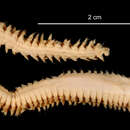tr
kırıntılardaki isimler


“Aglaophamus digitatus, new species
(Plate 20)
Record: 15:5 sta. 600 (1, TYPE).
Description: Length of an incomplete specimen is 62 mm, width 7 mm and setigerous segments number 62. The ventral oral field extends through segment 5. Involute interramal cirri are first present from segment 7; they are small at first but inscribe a complete coil in the anterior third of the body. The prostomium is elongate, oval, with the anterior end widest; it has a pair of very small frontal antennae at the outer ectal margin, and a much larger pair of ventral antennae inserted so as to lie beneath the extended first neuropodium. The posterior end of the prostomium tapers to a narrowed portion into the first setigerous segment, and the nuchal organs, partly everted, are visible through their darker color and elevated papillar form (Fig. A).
The proboscis (dissected) has many terminal papillae. Subdistally there are 14 longitudinal rows, with 10 to 16 in a row, diminishing in size proximally. The lowermost are smallest and each row furcates into 2 to 3 short rows of very small papillae. The proximal surface is smooth or wrinkled.
The first parapodium is large, directed forward at the side of the prostomium; its notopodial lobe consists of a conical acicular lobe with numerous strong camerated setae directed forward, and a slightly longer neuropodial lobe with a well developed ventral cirrus resembling the ventral pair of antennae; its setae are in a spreading fascicle.
The first few parapodia have smaller lobes than those farther back. A typical parapodium has a superior lobe which is completely fused with the postsetal lobe; in anterior segments it is slightly incised (Fig. B) but in middle and posterior segments it is entire (Fig. C).
The notopodial preacicular lobe is broadly rounded; the acicular lobe is prolonged, conical, with the emergent aciculum projecting from its longest part; the postsetal lobe is shorter, broadly rounded and continuous with the superior lobe. The notopodial cirrus is lanceolate, foliose, bluntly rounded in anterior segments and becoming slightly longer and distally pointed but always foliose in all segments. The involute interramal cirrus is coarse, thick, transversely wrinkled, and large through most segments.
Anteromedian neuropodia have a conspicuous erect lobe, a short, broadly rounded presetal lobe, a long, distally pointed, conical acicular lobe, and a shorter, broadly rounded postsetal lobe. Preacicular setae are camerated, shorter than postacicular setae, and less conspicuous except in anteriormost segments. Postacicular setae are long, flowing, with smooth or slightly serrated margins.
A. digitatus is characterized by its prolonged, ovate prostomium with poorly developed anterior antennae; the superior and postsetal lobes of notopodia arc fused; the acicular lobes are conspicuously prolonged and projecting.
Distribution: South Sandwich Islands, in 2531-2452 m."
(Hartman, 1967)
Aglaophamus digitatus is een borstelworm uit de familie Nephtyidae. Het lichaam van de worm bestaat uit een kop, een cilindrisch, gesegmenteerd lichaam en een staartstukje. De kop bestaat uit een prostomium (gedeelte voor de mondopening) en een peristomium (gedeelte rond de mond) en draagt gepaarde aanhangsels (palpen, antennen en cirri).
Aglaophamus digitatus werd in 1967 voor het eerst wetenschappelijk beschreven door Hartman.
Bronnen, noten en/of referenties